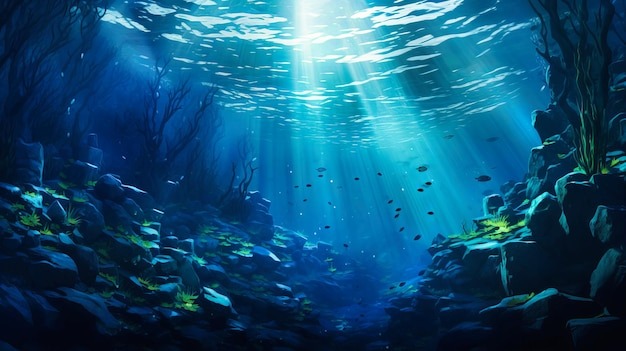Our planet is covered by vast stretches of water, with oceans making up more than 70% of Earth’s surface. Yet, despite being so massive, much of the ocean remains mysterious. Scientists estimate that we have explored less than 5% of these underwater worlds. Each journey into the ocean’s depths reveals new creatures, landscapes, and ecosystems. This article delves into the ocean, its unique features, and its hidden wonders, making it an exciting journey for anyone fascinated by the sea.
1. The Layers of the Ocean
The ocean isn’t just one vast expanse; it has layers, each with different features, temperatures, and ecosystems. Scientists divide the ocean into five main zones:
- Epipelagic Zone (Sunlight Zone): This is the topmost layer, stretching down to around 200 meters. It receives plenty of sunlight, supporting photosynthesis. Most ocean life is found here, including fish, sea turtles, and coral reefs.
- Mesopelagic Zone (Twilight Zone): This zone lies between 200 and 1,000 meters. Light fades quickly as you descend, making it darker and colder. Creatures here, like squid and jellyfish, have adapted to low light.
- Bathypelagic Zone (Midnight Zone): From 1,000 to 4,000 meters, this zone is pitch black. No sunlight reaches here, and temperatures drop to near freezing. Unique animals, such as anglerfish, have evolved to survive in this darkness.
- Abyssopelagic Zone (Abyss): Extending from 4,000 to 6,000 meters, this area is cold and quiet. Life here is scarce, with creatures like sea cucumbers and deep-sea worms adapted to extreme conditions.
- Hadalpelagic Zone (Trenches): This is the deepest part of the ocean, found in deep trenches and valleys. The Mariana Trench, for example, reaches over 10,000 meters below the surface. Only the toughest organisms, like some species of snailfish, can survive the intense pressure here.
2. Unique Ecosystems in the Ocean
The ocean is home to a range of ecosystems, each playing a vital role in Earth’s ecology. Here are some of the most fascinating:
- Coral Reefs: Often referred to as the “rainforests of the sea,” coral reefs support a vast array of marine life. Corals themselves are tiny animals, forming colorful colonies. They provide food and shelter for many species, including fish, shrimp, and sea turtles. However, coral reefs are highly sensitive to temperature changes, pollution, and overfishing.
- Kelp Forests: Kelp, a type of seaweed, grows in underwater forests along coastlines. These kelp forests offer shelter and food to fish, sea otters, and sea urchins. Kelp forests play an important role in absorbing carbon dioxide, which helps reduce climate change effects.
- Hydrothermal Vents: Found in the deep ocean, hydrothermal vents are cracks in the seafloor that release hot, mineral-rich water. Surprisingly, these vents host unique life forms, such as tube worms and certain bacteria. These organisms have adapted to thrive without sunlight, using chemicals in the water to produce energy, a process known as chemosynthesis.
- Open Ocean (Pelagic Zone): This vast, open water area may appear empty but is home to many large animals, including whales, sharks, and dolphins. These animals migrate across oceans, covering huge distances. The open ocean also has plankton, tiny organisms that drift with currents and form the base of the ocean’s food chain.
3. The Importance of the Ocean
The ocean is essential for life on Earth. Here’s why:
- Climate Regulation: Oceans absorb a significant amount of the sun’s heat, distributing it around the globe. This helps regulate climate and weather patterns. The ocean also absorbs carbon dioxide, reducing greenhouse gases in the atmosphere.
- Biodiversity: Oceans contain around 80% of all life forms on Earth. From tiny plankton to giant blue whales, this biodiversity supports food chains and ecosystems. Many of the ocean’s species are yet to be discovered, promising new insights and possibilities in science.
- Oxygen Production: Phytoplankton, tiny ocean plants, produce at least 50% of Earth’s oxygen through photosynthesis. These microscopic plants are crucial for life, not only in the ocean but on the entire planet.
- Food and Resources: Oceans are a major source of food, especially fish and shellfish, providing livelihoods for millions of people worldwide. Oceans also have resources like salt, sand, and minerals that are used in various industries.
4. Ocean Exploration and Technology
Exploring the ocean is challenging. High pressures, cold temperatures, and darkness make it difficult for humans to go deep underwater. However, advanced technology has made ocean exploration possible.
- Submersibles: Submersibles are small, specialized submarines designed for deep-sea exploration. Vehicles like Alvin and Deepsea Challenger have allowed scientists to study deep-sea life and geology.
- Remote-Operated Vehicles (ROVs): ROVs are uncrewed, robotic vehicles controlled remotely from ships. Equipped with cameras and sensors, they can explore dangerous and hard-to-reach areas, capturing high-quality footage of life deep underwater.
- Sonar and Mapping Technology: Sonar systems use sound waves to map the seafloor, helping scientists understand ocean geography. This technology is essential for studying trenches, ridges, and underwater volcanoes.
- Diving Suits and Advanced Equipment: Modern diving suits can withstand deep-water pressures, allowing divers to explore shallow and mid-depth areas. Specialized equipment, like underwater cameras and oxygen tanks, has enhanced our ability to explore coral reefs and other ecosystems.
5. Threats Facing the Ocean
Despite its importance, the ocean faces many threats due to human activity. These threats impact ocean life and ultimately affect human health and survival:
- Pollution: Oceans are heavily polluted with plastic waste, chemicals, and oil spills. Plastic waste, in particular, harms marine animals that ingest or get entangled in it. Toxic chemicals from industries flow into the sea, contaminating fish and other marine life.
- Climate Change: Rising temperatures and carbon dioxide levels are affecting ocean ecosystems. Coral reefs are bleaching, and species are struggling to adapt to changing conditions. Melting polar ice is also contributing to rising sea levels.
- Overfishing: Many fish populations are declining due to overfishing. Fish like tuna, cod, and haddock are being caught faster than they can reproduce. This imbalance disrupts food chains and endangers marine ecosystems.
- Ocean Acidification: As oceans absorb more carbon dioxide, they become more acidic. This process, called ocean acidification, harms shell-forming organisms like corals and certain shellfish, threatening marine food webs.
- Destructive Fishing Practices: Certain fishing methods, like bottom trawling, damage seafloor habitats. These practices destroy coral reefs, kelp forests, and other essential ecosystems.
6. Conservation Efforts
To protect the ocean, conservation efforts are underway globally. Some key initiatives include:
- Marine Protected Areas (MPAs): MPAs are designated regions where human activity is restricted to protect marine life. These areas help restore fish populations and protect vulnerable species.
- Sustainable Fishing Practices: Sustainable fishing involves catching fish at a rate that allows populations to replenish. Governments are setting fishing quotas and creating laws to prevent overfishing.
- Reducing Plastic Pollution: Many countries are working to reduce plastic waste by banning single-use plastics and encouraging recycling. Beach cleanups and awareness campaigns are also helping reduce ocean pollution.
- Climate Action: Addressing climate change is vital for ocean health. Reducing greenhouse gas emissions, protecting coastal ecosystems like mangroves, and promoting clean energy can help protect the ocean.
- Research and Awareness: Scientific research and awareness campaigns educate people about the ocean’s importance. Nonprofit organizations, scientists, and governments are working together to highlight ocean conservation.
7. Fascinating Facts about the Ocean
The ocean holds many surprises. Here are some fascinating facts:
- Largest Mountain Range: The longest mountain range is underwater, called the Mid-Ocean Ridge. It stretches over 40,000 miles across the globe.
- Deepest Point: The Mariana Trench is the deepest part of the ocean, reaching around 10,994 meters.
- Bioluminescent Creatures: Many ocean creatures, like jellyfish and certain fish, can produce light, a phenomenon called bioluminescence. This helps them attract mates, ward off predators, and hunt.
- Tsunamis: Underwater earthquakes, volcanic eruptions, or landslides can cause massive waves called tsunamis. These waves can travel at speeds over 500 miles per hour and are highly destructive when they reach land.
- Diversity of Life: Scientists estimate there could be millions of undiscovered species in the ocean, especially in the deep sea.
8. The Future of Ocean Exploration
As technology advances, our ability to explore and understand the ocean will grow. New devices, artificial intelligence, and satellite imaging will reveal more about ocean ecosystems, allowing us to better protect them. Future missions aim to explore the deep sea, study marine species, and uncover ocean resources that could benefit humanity.
Yet, with exploration comes responsibility. Protecting the ocean is crucial for sustaining life on Earth. As we continue to uncover its mysteries, we must also work to preserve its beauty, resources, and ecosystems.
Conclusion
The ocean is more than just water; it is a world of wonder and importance. From supporting diverse life forms to regulating the climate, its role in Earth’s



